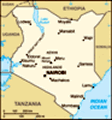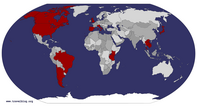Advertisement
Published: June 13th 2017
Geo: 0.598744, 37.4991
DAY NINE (Saturday, September 12, 2009)
More than lions & tigers & bears … oh, my
OK, I like Amboseli much better today. I've decided the road in here made me so cranky that I couldn't like anything yesterday.
This morning was different. As I was brushing my teeth, I heard branches cracking right outside my window. I opened the drapes and about 30' from my window were 8 elephants parading to the water right by our room. They stopped, drank and ate. Very fun to have this going on so close by.
Our game drive left before dawn so we could see all the animals on the move. And we did that. We had Mike and Mary Ann Schuermann with us again, which is always a hoot.
All the regulars were out (zebras, wildebeests, gazelles, hippos, Cape buffalo, etc.) and most were on the move. They were either chasing breakfast or running for their lives. Some were more successful than others.
It is fascinating to watch a lioness work the room. She is smooth, sly and stealthy. We didn't actually see them take anything down, but we saw one lioness scatter a lot of herds, just with her approach.
The hyenas are another matter. 
 Grevy zebra
Grevy zebra
bigger ears, thinner stripesThey are scraggly and ugly, with a strange uneven gait. They are scavengers. This morning we saw them tearing apart a wildebeest one place and a Cape buffalo another. In both cases, the vultures were waiting their turn. When the rainy season comes, and food is scarcer because animals are healthier and not dying off, the hyenas resort to eating hides and bones. Their poop is white as a result, just in case that subject ever comes up in your trivia games.
We trekked to the top of a mound which gave a good view of the whole park, including wading hippos and white pelicans. Kilimanjaro was hidden under a layer of clouds today, which was disappointing.
When we returned to the Lodge, we had breakfast; I finally got on the internet by taking my laptop to the lobby. In the gift shop I picked up four souvenirs items to take back as gifts and a cute white tee shirt that has an illustration of a zebra on the front, and a view of a zebra's behind on the behind.
Rachel then gave us a briefing on the Maasai. (See box below.) For centuries, Maasai have been farmers, herders, hunters. Many Maasai

 Gerenuk
Gerenuk
Giraffe-type antelope that stand on rear legs to get to the good vegetationwarriors are now often employed outside their tribe as security guards to private business and private homes. Even our Tauck guides have warriors protect their homes while they are traveling with us.
THE MAASAI
The Maasai are an indigenous African group of semi-nomadic people located in Kenya and northern Tanzania.
- Maasai are pastoralists and have resisted the urging of government to adopt a more sedentary lifestyle. They have demanded grazing rights to many of the national parks and are admired for their ability to farm in deserts and scrublands.
· Traditional lifestyle centers around their cattle which constitutes the primary source of food. The measure of a man's wealth is cattle and children.
· The mixing of cattle blood, obtained by nicking the jugular vein, and milk is done to prepare a ritual drink for special celebrations and as nourishment for the sick.
· The traditional Maasai house is designed for people on the move and very impermanent in nature. The framework is formed of timber poles interwoven with a lattice of smaller branches, plastered with a mix of mud, sticks, grass, cow dung, human urine and ash. The cow dung ensures the roof is water-proof.
· The central unit of Maasai society is the age-set. Young boys are sent out with the calves and lambs as soon as they can toddle; girls are responsible for chores such as cooking and milking. Each new generation of Morans involves most boys between 12 and 25. One rite of passage to the status of warrior is a painful circumcision ceremony, performed without anaesthetic. The boy must endure the operation in silence since expressions of pain bring dishonor. The warriors are in charge of society's security, and spend most of their time on walkabouts throughout Maasai lands.
· One myth about the Maasai is that each young man is supposed to kill a lion before they are circumcised. Although lion hunting was an activity of the past, and lion hunting has been banned in East Africa, lions are still hunted when they maul Maasai livestock. Killing a lion gives one celebrity status in the community.
· Young women also undergo "female circumcision"
as part of an elaborate rite of passage; the most common form is clitorectomy. Criticism has resulted in it being illegal in Kenya and Tanzania.
· The Maasai are traditionally polygamous, due to high infant and warrior mortality rates. Polyandry is also practiced; a woman marries not just her husband, but the entire age group.
· Eunoto, the coming of age ceremony of the warrior, includes adumu, a sort of competitive jumping, with a circle of warriors, where one or two at a time enter the center to begin jumping while maintaining a narrow posture, never letting their heels touch the ground. The girlfriends of the Moran parade in spectacular costumes. The traditional attire for the men is the wearing a shuka (colourful piece of cloth), cow hide sandals and carrying a wooden club (o-rinka). Warriors wear jewelry and other decorations.
· Beadworking
has a long history among the Maasai, who articulate their identity and position in society through body ornaments.
· Head shaving is common at many rites of passage, representing the fresh start made as one passes from one to another of life's chapters. Warriors are the only members of the Maasai to wear long hair.
· Recently, governments have attempted to help Maasai tribal leaders find ways to preserve their traditions while balancing the education needs of their children for the modern world. The emerging forms of employment among the Maasai people include farming, business (selling of traditional medicine, running shops, selling milk products), and wage employment (as 
 Young zebra
Young zebra
Common zebra youngster has brown manesecurity guards/ watchmen, waiters, tourist guides).
Back to the trip ... we are all in agreement this property is the best we have encountered so far. (It's in Conde Naste's top 200 hotels of the world.) Service levels and food are superior; rooms are nice with clever décor. Too bad the park isn't worth the visit.
Following lunch, we board our 4x4s and headed to the airstrip to fly Air Kenya to Samburu and the Samburu Serena Safari Lodge. The Amboseli property quickly fell to second place.
The hotel and staff are decorated in bright Maasai colors (Maasai are called "Samburu" here.) Spears and other tribal items are used throughout. Our room, another hut, is right by the pool, where more of the vervets reside. Careful to keep those screens and doors closed.
At 4 pm, we headed out on an afternoon game drive. This property is gorgeous. It's high desert, with interesting plants, an abundance of greenery and lovely backdrops for my animal photos. I'm all about the pictures, after all.
NOTE: Many folks, like me prior to doing research for this trip, think of safaris and Africa as being jungle … with all the heat and humidity to go with it. Although it has been quite warm during the day on many days, it has also been quite cool in the evenings. Plan on removing layers as the day progress, and adding the layers back on as the sun goes down. Samburu in the high desert is a perfect example.
Much to our surprise, although we saw a few old friends (impala, gazelles and the like), most of the animals we spotted this evening were new to us:
1. The Grevy zebra, with its mule ears, thinner stripes and white butt and belly. Very cute, just different.
2. The Oryx, a larger gazelle than the impala or Grant's. Saw babies too.
3. The gerenuk, a darling antelope that stands on its rear haunches to eat from trees, similar to where the giraffes feed. We saw a family – all were gorgeous, thin and fit like Olympic athletes.
4. The reticulated giraffe … the brown one with a hide that looks like flagstones … the kind you see in most zoos. There is an abundance of them and they were all roaming around just before the sun settled. Turns out this giraffe lives in the Northern Hemisphere; the Maasai Giraffe lives in the Southern Hemisphere. Do they know not
to cross the equator?
Mike's a camera buff too so we asked Stephen our guide to stop some place interesting for sunset photos. We had an unusual tree (big, old, gnarly and very dead) between us and the sun as it went behind a hill. Interesting shots.
Then as we headed back to the lodge, we rounded the hill and discovered the sun was still there, so we nabbed a few more sunset photos with umbrella acacia in them. I'm lovin' sunsets here. Guess it's the dust that creates the colors.
The dining room is in the lobby … very open air with warrior décor strewn throughout. The grill food was yummy and so was the atmosphere. Lovely ending to a lovely day.
Before I close, I need to share the “blog” my sister Debby sent to some friends today. She is following my blog, enjoying the pictures, but simply doesn't get why someone would travel to Africa. She knows I am missing my Golden Retrievers and my Tab soda desperately. Here goes:
Day One:
Awoke to the comfort of 600-count threads on my pillow-top mattress. No mosquito netting needed as the air conditioning is working great. Moved to breakfast being served in the kitchen with no escort needed to keep me safe from wildlife outside.
Went to work in my Cadillac that has a lovely suspension and doesn't jar my teeth when riding in it. No dust storms swirling today as there is a calming autumnal breeze outside.
Took photos of local wildlife: Monarch butterfly, ruby-throated hummingbird, black snake, Labrador retrievers. No animals threatened my life so I felt comfortable getting out of my car. Also no birds of prey ate each other while I was looking.
Had a dinner of fresh fruit, vegetables and chicken, which I washed down with a Tab. Another day in paradise, Wildwood, Missouri style.
She is such a wench. But a funny one.
Advertisement
Tot: 0.251s; Tpl: 0.019s; cc: 10; qc: 50; dbt: 0.0503s; 1; m:domysql w:travelblog (10.17.0.13); sld: 1;
; mem: 1.2mb




















